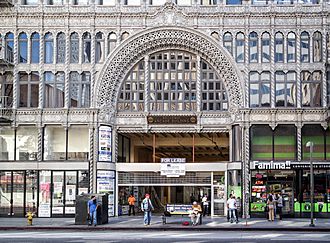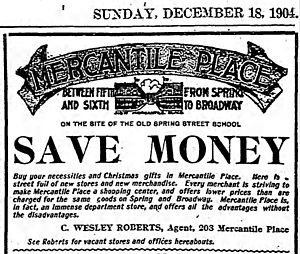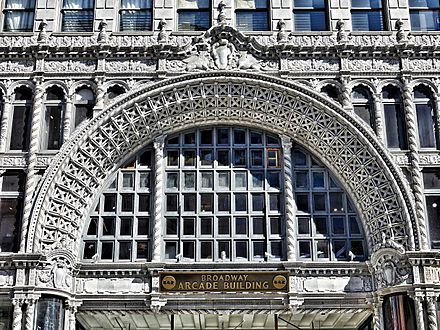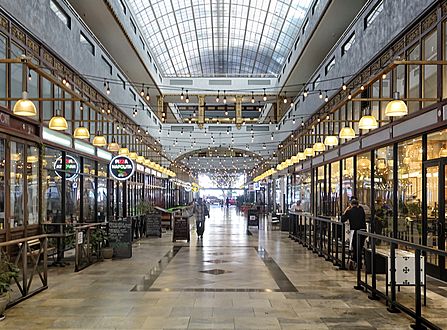Spring Arcade facts for kids
Quick facts for kids Spring Arcade Building |
|
|---|---|

Arcade building, Broadway side, 2014
|
|
| Former names | Broadway Arcade |
| General information | |
| Architectural style | Beaux Arts, Spanish Baroque |
| Classification | Historic |
| Town or city | Downtown Los Angeles, California |
| Country | United States |
| Coordinates | 34°02′48″N 118°15′03″W / 34.046607°N 118.250744°W |
| Opened | 1924 |
The Spring Arcade Building is a famous landmark in Downtown Los Angeles. It is also known as the Broadway Arcade. This building is actually three buildings connected together. They opened in 1924.
The Spring Arcade Building stands where an older place called Mercantile Place once was. Before that, a schoolhouse used to be on this spot. The building faces both Broadway and Spring Street. It is built in the beautiful Beaux Arts and Spanish Baroque styles.
Contents
Early History of the Land
Spring Street School Site
In 1883, the Los Angeles school board bought the land where the Spring Arcade Building now stands. They paid $12,500 for it. The first building on this land was the Spring Street School.
Mercantile Place Development
By 1904, the land had become very valuable. The school board decided to lease it out instead of selling it. They kept the materials from the old brick schoolhouse, which was a well-known building.
Work began on Mercantile Place that year. It was a new idea for Los Angeles. C. Westley Roberts leased the land from the school board. He planned to create a new street through the property. This new street would be called an "arcade." It would have stores and offices on both sides. The arcade was designed to be 40 feet wide, paved, and brightly lit.
Mercantile Place Businesses and Life
Mercantile Place opened around 1905. It soon had many businesses. These included a Woodmen of the World lodge hall and a large hairdressing and beauty college.
As the lease neared its end in 1913, the land's value had grown a lot. The school board considered selling it. However, voters chose to lease the property for fifty years instead.
Mercantile Place was a very busy spot. In 1911, hundreds of people gathered there. They watched for election updates during a mayoral race. By the early 1920s, the private street was full of people, cars, and shops. It was a lively place with fruit and vegetable trucks, flower markets, and even fireworks vendors.
The Spring Arcade Building
Planning and Construction
In 1919, the school board sold the property for $1.155 million. It was later sold again to a group of San Francisco businessmen. They planned to build something grand.
An architecture contest was held. The winning design called for two twelve-story office buildings. These would be on the Broadway and Spring Street sides. A three-story arcade building would connect them. This arcade would have a glass roof. The first three floors of both office buildings were designed for stores. The arcade itself would be 40 feet wide. It would be a walkway for people through the middle of the block. A very large cafeteria was also planned for the basement.
Work to tear down the old Mercantile Place buildings started in April 1923. Building the new Spring Arcade was a big job. The workers had to make the foundations of the nearby buildings much deeper. This was a difficult and important part of the construction.
The new buildings went up quickly. The steel frame for the Broadway building was done in just two months. The Spring Street building's frame was finished soon after. The three-story Arcade building was also completed fast. Its large skylight needed over 18,000 feet of glass.
Grand Opening
Businesses began moving into the Arcade by January 1925. The building was advertised as a "City Within a City." The Spring Street side was mostly for financial businesses. The Broadway side was for general offices and shops.
When the Arcade officially opened in February 1924, it was a big event. Special attention was given to Crane's Arcade Barber Shop. Each customer received a clean hairbrush, lather brush, and comb. Desmond's Men's Arcade Shop and a new See's Candy store also opened. Other notable tenants included a large hair and beauty parlor and a Western Union office.
The building's design was very beautiful. The walls and tiles had soft blues and reds. This made the shops look like pictures in a frame. The co-architect, Kenneth MacDonald Jr., pointed out the "great charm" of the delicate terra cotta decorations on the first three floors.
Later Years and Changes
From its early days, the Arcade housed a U.S. Post Office branch. It paid very little rent at first, but the rent increased over time. The branch eventually closed in 1946.
In 1932, radio station KRKD put two tall broadcast towers on the Arcade's roof. These towers are still there today. They were once used for radio signals but are not anymore. In 2014, a plan to remove them was stopped because they are a historic landmark. The towers were later painted and lit up.
In 1940, twelve bowling lanes were added to the Broadway Arcade building. In 1953, there was a plan to turn the space under the Arcade into an underground parking garage.
Decline and Renovation
By 1977, the Broadway-Spring Arcade was seen as an underused building. There were ideas to turn it into housing for older people. In the 1980s, the Joseph Hellen family bought the Arcade buildings.
In 2002, plans were announced to turn the building into 142 loft-style apartments. This was part of a $15 million renovation. The owner reportedly spent $45 million to update the buildings.
In the 1990s, the arcade was very busy with shoppers. However, by 2012, the number of shoppers had gone down. Many stores became empty. A reporter noted in 2012 that the 88-year-old shopping arcade, with its beautiful skylight and Spanish Renaissance style, had many vacant stores. The remaining shops seemed to be from another time, selling old electronics and T-shirts from 90s rock bands.
Today, the Spring Arcade Building has been renovated. It now has a mix of shops, restaurants, cafes, and bars on its ground floor.
Gallery




